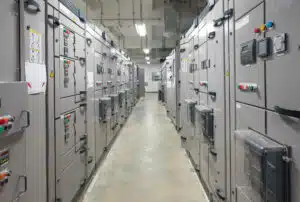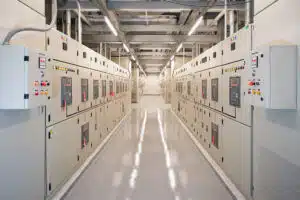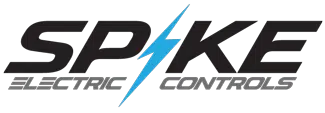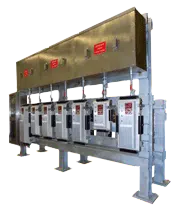Metal-clad and metal-enclosed switchgear are two common types of switchgear used in electrical power systems. While they share some similarities, there are also significant differences between them. In this technical blog, we will explore the key differences between metal-clad switchgear and metal-enclosed switchgear.
Metal-Clad Switchgear IEEE C37.20.2
 Metal-clad switchgear is a type of switchgear that is designed to provide a high level of protection to electrical power systems. This type of switchgear is typically used in medium voltage applications, typically between 2.4 kV and 38 kV. Metal-clad switchgear consists of separate compartments for the busbars, circuit breakers, and other components, each of which is enclosed in a separate metal enclosure. The enclosures are connected by busbars, which are also enclosed in their own metal enclosures.
Metal-clad switchgear is a type of switchgear that is designed to provide a high level of protection to electrical power systems. This type of switchgear is typically used in medium voltage applications, typically between 2.4 kV and 38 kV. Metal-clad switchgear consists of separate compartments for the busbars, circuit breakers, and other components, each of which is enclosed in a separate metal enclosure. The enclosures are connected by busbars, which are also enclosed in their own metal enclosures.
The main features of metal-clad switchgear are as follows:
- Each compartment is fully enclosed in a metal housing, which provides protection against accidental contact with live parts.
- The circuit breaker is typically located in its own compartment, which is separate from the busbars.
- The busbars are enclosed in their own metal housing, which is separate from the circuit breaker compartment.
Metal-Enclosed Switchgear IEEE C37.20.1
 Metal-enclosed switchgear is a type of switchgear that is designed to provide a high level of protection to electrical power systems. This type of switchgear is typically used in low-voltage applications, typically up to 1 kV. Metal-enclosed switchgear consists of a single metal enclosure that houses all the components of the switchgear, including the circuit breakers, busbars, and other components.
Metal-enclosed switchgear is a type of switchgear that is designed to provide a high level of protection to electrical power systems. This type of switchgear is typically used in low-voltage applications, typically up to 1 kV. Metal-enclosed switchgear consists of a single metal enclosure that houses all the components of the switchgear, including the circuit breakers, busbars, and other components.
The main features of metal-enclosed switchgear are as follows:
- All the components of the switchgear are enclosed in a single metal housing.
- The circuit breaker is typically located in the same compartment as the busbars.
- There are no separate compartments for the busbars or other components.
Differences between Metal-Clad and Metal-Enclosed Switchgear
The main differences between metal-clad switchgear and metal-enclosed switchgear are as follows:
- Enclosure Configuration: Metal-clad switchgear has separate enclosures for each component, while metal-enclosed switchgear has a single enclosure for all components.
- Voltage Rating: Metal-clad switchgear is typically used in medium-voltage applications, while metal-enclosed switchgear is typically used in low-voltage applications.
- Compartmentalization: Metal-clad switchgear is compartmentalized to separate the circuit breaker from the busbars and other components, while metal-enclosed switchgear has all components in the same compartment.
- Accessibility: Metal-enclosed switchgear provides easy access to all components, while metal-clad switchgear may require more effort to access each component.
- Space Requirements: Metal-clad switchgear requires more space due to the separate compartments, while metal-enclosed switchgear requires less space.
Conclusion
In conclusion, metal-clad switchgear and metal-enclosed switchgear are two common types of switchgear used in electrical power systems. While they share some similarities, they also have significant differences in terms of their enclosure configuration, voltage rating, compartmentalization, accessibility, and space requirements. Understanding the differences between these two types of switchgear can help engineers to choose the appropriate type for their specific applications.
Written by: Cole Attaway
Cole Attaway is the founder and CEO of Spike Electric Controls. Spike's mission is to improve the accessibility and delivery of industrial electrical gear for clients nationwide. Spike solutions result in reduced unplanned downtime, less overtime, and greater operational efficiencies.


